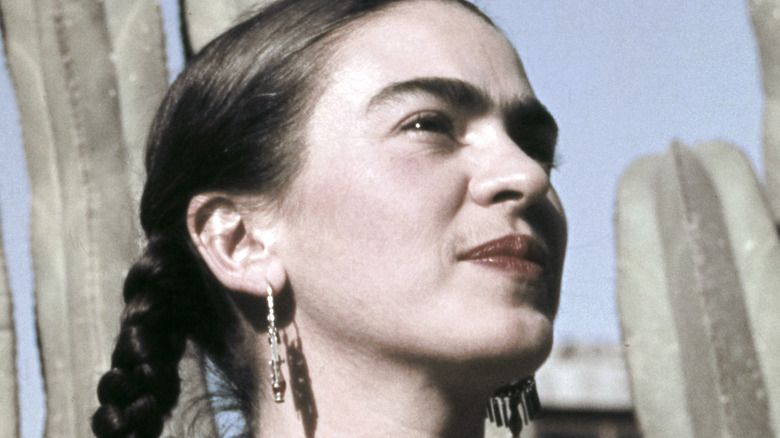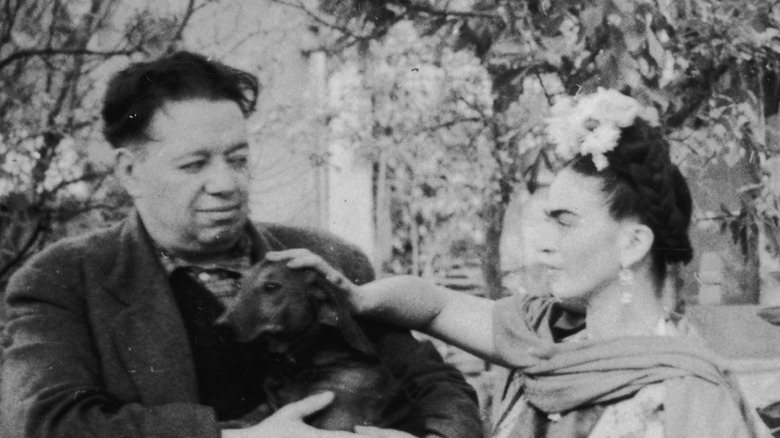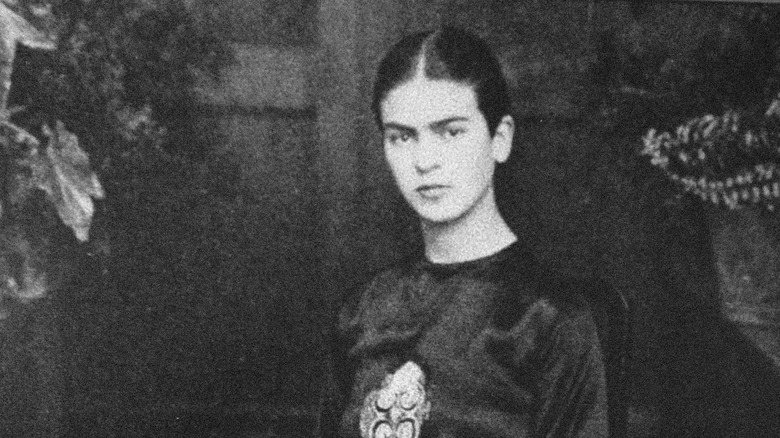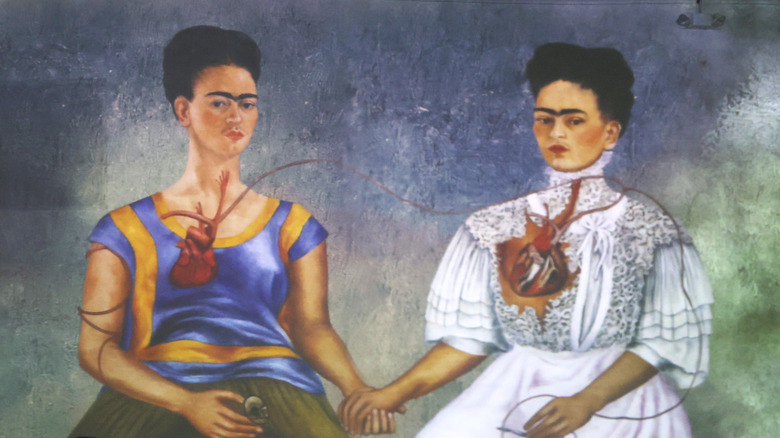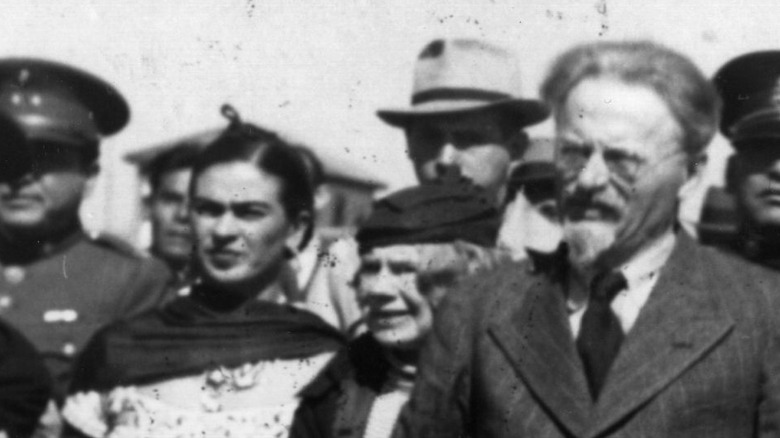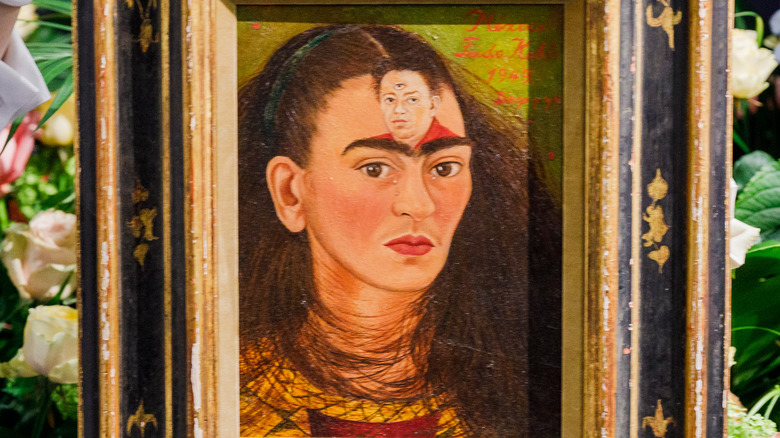What Really Led To Frida Kahlo's Affair With Leon Trotsky
Frida Kahlo is a feminist icon, worshipped for not only her paintings that depicted pain and passion in vibrant, striking colors, but also for her innovative fashion and style. Kahlo was born in Mexico City, where her "Blue House" today has been converted to a museum that attracts two million visitors each year (via Art Radar Journal). A self-taught painter, Kahlo's work frequently depicted her personal life struggles. Born to a German photographer father and a native Mexican mother, many of her paintings showed the dichotomy she felt between her indigeneous and colonial European heritage (via Britannica).
Although Kahlo's work certainly stood on its own, part of what led to her fame was her marriage to the renowned Mexican muralist Diego Rivera. The two have a love story as passionate and unique as their work. But while most people know the story of Frida and Diego, not everyone knows about another romance Kahlo shared with the Russian-Ukrainian Marxist revolutionary Leon Trotsky.
Frida meets Diego
As a girl, Frida Kahlo was one of only 35 girls that attended the National Preparatory School in Mexico City, where she first saw Rivera painting the mural "The Creation," and told her friend she would "marry him someday," according to Fridakahlo.org. Although at the time she was just 15 and Rivera was 36, they reconnected once Kahlo got out of school and the two were married in 1929.
Frida, weighing about 100 pounds, was smitten with Rivera, who towered above her small frame. Kahlo's parents, who didn't exactly agree with their daughter marrying someone more than 20 years her elder, said their relationship was like a "marriage between an elephant and a dove," according to Smithsonian Magazine. Still, the union between two of Mexico's greatest artists seems like it was destined to be, with the two encouraging and critiquing each others' work while journeying together through a winding roller coaster of a love story.
Frida's accident
The two spent many happy years traveling around for various murals Rivera was commissioned to paint in San Francisco, New York City, and Detroit before returning to Mexico. However, one of the great tragedies of Frida Kahlo's life was that she was unable to bear children and went through many miscarriages. This was part of the reason the couple had such a troubled relationship.
When she was 18 years old, a bus accident changed Kahlo's life. During the accident, a piece of metal from the seat pierced her pelvis and fractured it in three places, according to Smithsonian Magazine. Barely surviving the accident, she was left with crippling pain that followed her throughout the rest of her life and became the subject of many of her paintings.
But that wasn't all that took place in Kahlo's sad childhood. Earlier, she was diagnosed with polio that left her with a limp, as well as other health problems (via Britannica). On the other hand, it was after the bus accident that Kahlo, confined to her bed, started painting with fervor.
Frida's politics
Kahlo was always outspoken and drawn to politics. Both she and Rivera were members of the Communist party, and one of Rivera's famous Rockefeller Center murals controversially included a portrait of the party's leader Vladimir Lenon (per Smithsonian Magazine). Rivera even coordinated with the Mexican government to allow the founder of "Trotskyism," which both Kahlo and Rivera followed, to seek refuge in the country after he was exiled.
According to Artsy, Kahlo and her husband both wanted a change in power to a populist government, an idea that was often portrayed in their work. In one of Rivera's paintings, "The Arsenal," for example, Kahlo wears a bright red star on her chest to represent communism as she hands out weapons to the working class. On home soil, they were activists in "Mexicanidad," a movement that promoted indigenous rights and aimed to strip Mexico of its colonialist past.
Frida's affair
In 1937, Trotsky and his wife were welcomed into Kahlo and Rivera's "Blue House," where Kahlo and Trotsky developed a romance (per Smithsonian Magazine). Because Trotsky's wife did not speak English, the lovers were able to communicate discreetly under her nose, with Trotsky passing love letters to Kahlo in her books, according to Artsy. She called him "el viejo," meaning "old man," and in one such love note, he wrote to her, "I found myself the owner of a set of principles in which I snuggled like a beaver, and dodged the ghost of your mustache," per Smithsonian Magazine, Clarin.
Although the affair didn't last long, it seemed to have struck a chord in Kahlo's heart. She did paint Trotsky a portrait of himself, and gifted him a full-length portrait of herself for him to keep. However, Rivera and Kahlo later became Stalinists, and when Trotsky wrote to her to try and express his love, she ignored him. In an unlikely coincidence, Kahlo ended up meeting with Trotsky's murderer the year before he killed him with an ice pick and was brought in for questioning by the police.
The other affairs
This isn't to create the impression that Kahlo was an unfaithful partner. She was extremely dedicated to Rivera, bringing him "lunch every day, bathing him, [and] cooking for him," according to Smithsonian Magazine. Rivera was equally smitten, saying upon first meeting that, "I did not know it then, but Frida had already become the most important fact in my life. And would continue to be, up to the moment she died, 27 years later," (via Spanish Mama).
The two separated and reunited several times throughout their relationship, and there was more than one affair that took place among both parties. Kahlo, who was bisexual, also had affairs with Dolores del Rio, Paulette Goddard and Maria Felix, according to Respectability.org. Reportedly, Rivera encouraged these relations because he was also infamous for having affairs, including one with Kahlo's younger sister, Cristina (via Smithsonian Magazine).
Although the affair with her sister perhaps took it too far, Kahlo also seemed to share an openness to multiple lovers — once saying "Fall in love with yourself, with life, and after whoever you want" (via La Razón).
